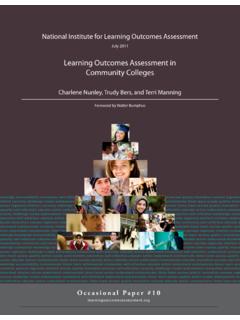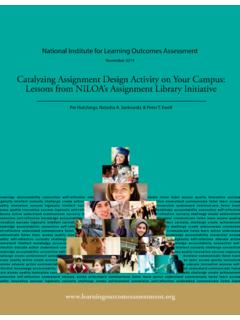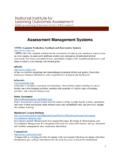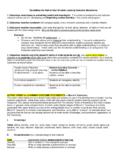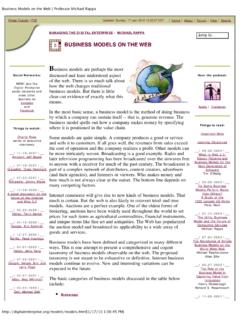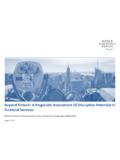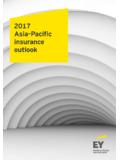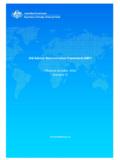Transcription of How an Outcomes-Based Curriculum Enables …
1 1 How an Outcomes-Based Curriculum Enables authentic assessment Jacob Amidon, Assistant Vice President of Academic Affairs Debora Ortloff, Chief Officer for assessment , Planning, and Continuous Improvement Finger Lakes Community College Finger Lakes Community College (FLCC), established in 1965, is a medium-sized community college located midway between Syracuse and Buffalo in the heart of upstate New York. FLCC has a four-county service area that is mostly rural, but includes two small urban centers. FLCC is one of 31 community colleges in the State University of New York (SUNY) system, which also includes 34 additional institutions of higher learning. FLCC s enrollment is approximately 6,500 students annually, made up of approximately 30% transfer students, 20% terminal degree-seeking students, 40% dually-enrolled high school students, and 10% in certificate programs or non-matriculated.
2 For the past three and a half years, FLCC faculty and staff have been engaged in a governance-led comprehensive reform initiative, which we call the Learning Framework. The Framework moves our Curriculum to a wholly Outcomes-Based set of local requirements that privilege our own institutional learning outcomes, which we call the FLCC values, while also including our state and regional accreditation requirements for General Education. Additionally, the reform initiative formally adopts the outcomes as guidelines for co-curricular activities and mandates the inclusion of First-Year Experience outcomes and Capstone outcomes in every program. The Learning Framework represents the largest curricular and assessment reform in the College s 50-year history. In this piece, we posit broadly that large-scale Outcomes-Based reform, tied to the local values of the institution, allows for wider stakeholder participation, creates curricular flexibility and engenders an authentic assessment process.
3 In order to demonstrate this point, we detail the creation and implementation processes that we have used at FLCC in pursuit of the Learning Framework. CREATING THE FRAMEWORK External Curricular and assessment Pressure In June 2013, the SUNY system adopted a policy known broadly as Seamless Transfer that contained a number of mandates for the curricular make-up of all degree programs in order to allow students to seamlessly transfer within the SUNY system. To ensure inclusion of courses for both general education and for program requirements, we had to reduce all of our associate s degrees to no more than 64 credit hours. Through this process, we found that 91% of our programs were out of compliance with some aspect of the mandate, some extremely so, requiring assessment in Practice 2 us to make a large number of curricular changes in a short time.
4 In particular, most of our programs had to remove required courses both to meet the 64 credit limit and to make room for the additional mandated coursework. For many educators at FLCC this combination felt like a dramatic loss of control over the Curriculum . At the same time, the College received a series of recommendations from our 10-year accreditation process, many of which broadly asked us to better articulate the wide-variety of learning outcomes and consequently communicate them more effectively to our students. Furthermore, our regional accreditor, Middle States Commission on Higher Education (MSCHE) released a draft of a new set of standards, containing additional requirements to incorporate into our general education Curriculum . Many educators at FLCC were left to ask: where, in this sea of the SUNY system and Middle States, do we still see FLCC?
5 Internal Inefficiencies FLCC has a long history of academic assessment , although, we, like many schools received recommendations to improve our assessment of student learning from our regional accreditor. In reality though we had multiple sets of outcomes local, SUNY, and regional accreditor specific outcomes but none of them mapped to each other in any significant way. Consequently, we had three different areas of assessment all of which required different processes to create, assess and report. As discussion began about the need for a new way forward holistically, the co-leaders of the initiative (and authors of this paper) created this graphic to explain the current assessment system. If this graphic hurts your eyes, it accomplished its goal. Taking on large scale reform is not an easy task and should not be undertaken lightly.
6 This graphic was meant to demonstrate that despite our well-intentioned path to assessment , opportunities for improving teaching and learning were lost in complex and departmentalized processes that promoted assessment and then more assessment , but not good, sustained and systematic conversations about teaching and learning. 3 The Learning Framework The graphic above helped demonstrate that we needed new and more comprehensive blueprints. The resulting plan, went through many stages of drafting and re-drafting (link to graphic organizer). It lost a column, gained stairs, and added other features as we worked to represent and assess the uniqueness of an FLCC education. To summarize the key features of our new Learning Framework: Subsumes everything under FLCC values which are both Institutional Learning Outcomes (ILO) and conceptually serve as values for the college Fully Outcomes-Based Meets external requirements, but privileges outcomes we have defined locally Serves as outcomes for both curricular and co-curricular efforts For more information on the Framework, including all of our outcome language see: 4 BENEFITS OF THE FRAMEWORK The most direct benefit to this model is the opportunity for educators at FLCC to define and defend their Curriculum while still meeting external requirements.
7 There are some key ways that this manifested in the reform initiative. Initially, it allowed us to shift conversations, at a time of high tension because requirements were changing, to focus on the higher ideals of education by asking the educators at FLCC What makes us unique? The rhetoric of a reform initiative focused on what is special about an FLCC education recasts assessment as a tool for good, rather than a bureaucratic act tied to checking boxes and meeting deadlines. Further, this unique FLCC approach quickly allowed us to broaden the conversation quite dramatically to include the whole campus community. Governance representatives from the registrar s office, advising, student affairs, the Library and others were intentionally represented in the conversation.
8 Service departments, like Marketing and Human Resources, accessed the higher-level discussion of our values to consider in their work. There was a much stronger push to have a set of values for FLCC that transcended the traditional general education outcomes to indicate what we valued that set us apart from other colleges. Focusing on a larger discussion of what we, as a campus, value brought in more people to the conversation while still allowing the policy and procedure changes necessary for Curriculum and assessment to function, to continue. However, beyond this initial ability to saliently connect the FLCC experience to include a greater breadth of educators in the creation process, there are some important benefits in the long-term because an outcomes based approach, like this, creates curricular flexibility and supports authentic assessment .
9 Distribution models, commonly used in the design of General Education programs, forces educators to think in boxes. In verifying student completion, we check the box: 1 computer science credit . Even pseudo Outcomes-Based approaches do this: complete technological literacy outcome by taking 1 approved course in computer science . An outcomes approach that describes what is meant by technological literacy not only gives a good understanding of what we want the students to learn, but also naturally sets up the assessment process to inform us on the student s progress in meeting those outcomes. Further, this approach also helps us overcome curricular restraints in that an outcome is more portable because it can be incorporated into a wider range of courses or even into co-curricular activities.
10 While any approach to Curriculum will inevitably look at the course level, the benefit to a fully Outcomes-Based approach is the ability to think about the wide variety of learning that exists. In other words, when the learning outcome is the primary vehicle by which the Curriculum is built, the assessment of that outcome tells the story of that learning. As we moved toward implementation, this change in the way we as educators were beginning to think about the relationship between Curriculum building with outcomes and student learning was at the forefront of our minds. IMPLEMENTING THE FRAMEWORK We did employ a number of key strategies that helped us build the Framework at FLCC, but, as with many reform initiatives the ideas and planning are easier than implementation.



